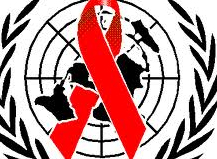There is a major conference on HIV/AIDS underway at the United Nations this week. AFP has some video highlights from the opening session:
The meeting will conclude tomorrow with the adoption (by consensus) of a document “which will guide country responses to HIV over the next five years.”
In the meantime, this meeting is timed to coincide with the 30th anniversary of HIV. A few things to keep in mind:
Health interventions over the past ten years or so have begun to slow down the spread of HIV. Global rates of new HIV infections have fallen by nearly 25% between 2001 and 2009. Technological innovations–like the ability to (inexpensively) prevent the mother to child transmission of HIV — have contributed to this success. Also, better treatment options mean that fewer people are dying from AIDS. This chart from the Economist speaks volumes.
The story of AIDS right now is overwhelmingly positive. It turns out that as a species, we can come together for the global good to fight our common enemies.
UPDATE: Efforts to prevent mother to child HIV transmission just got a nice boost. From the State Department:
U.S. Global AIDS Coordinator Ambassador Eric Goosby pledged an
additional $75 million for preventing mother-to-child transmission during the 2011 High Level Meeting on AIDS. World leaders gathered in New York at the June 8-10 event committed to a global action plan that will make significant strides towards eliminating new HIV infections among children by 2015 and keeping HIV infected mothers alive.
Nearly every minute, a baby is born with HIV. A child dies of AIDS every two minutes and one of every five maternal deaths in Africa is
HIV-related. Neither technical or scientific barriers stand in the way of eliminating pediatric AIDS worldwide. Pediatric HIV was virtually eliminated, with fewer than 150 new cases per year, in the United States and Europe more than a decade ago.
The world has made incredible progress in closing the gap in developing countries thanks in great part to the commitment of the American people. In fiscal year 2010, the U.S. President’s Emergency Plan for AIDS Relief (PEPFAR) programs focused on preventing mother-to-child-transmission directly supported services that led to more than 114,000 children estimated to have been born free of HIV.
The key elements of the global action plan include:
* All women, especially pregnant women, have access to quality
life-saving HIV prevention and treatment services- for themselves and their children.
* The rights of women living with HIV are respected and that
women, their families and communities are empowered to fully engage in ensuring their own health- especially the health of their children.
* Adequate resources- human and financial- are available from
both national and international sources in a timely and predictable
manner while acknowledging that success is a shared responsibility.
* HIV, maternal health, newborn and child health, and family
planning programs work together, deliver quality results and lead to
improved health outcomes.
* Communities, in particular women living with HIV, are enabled and empowered to support women and their families to access the HIV prevention, treatment and care that they need.
* National and global leaders act in concert to support country
driven efforts and are held accountable for delivering results.
The global action plan includes a detailed timetable for action at
community, national, regional and global levels to ensure rapid progress towards elimination of new HIV infections in children by 2015 and keeping HIV positive mothers alive.
In addition to this week’s U.S. contribution for the prevention of
mother-to-child HIV transmission the Bill & Melinda Gates Foundation pledged $40 million, Johnson & Jonson added $15 million, and Chevron committed $20 million.

